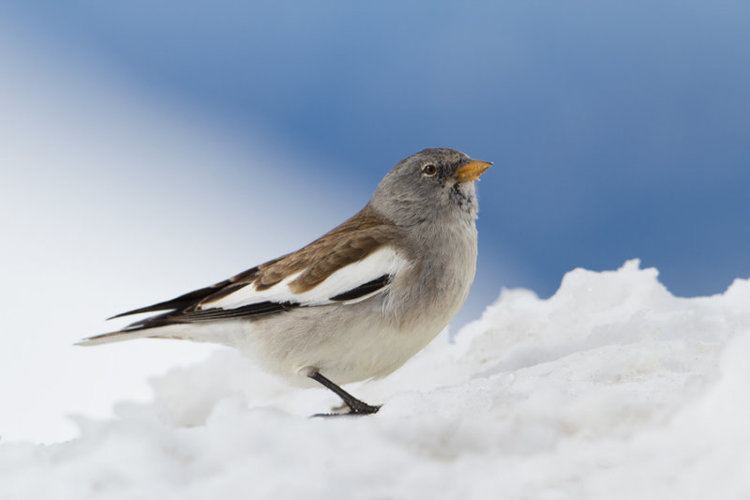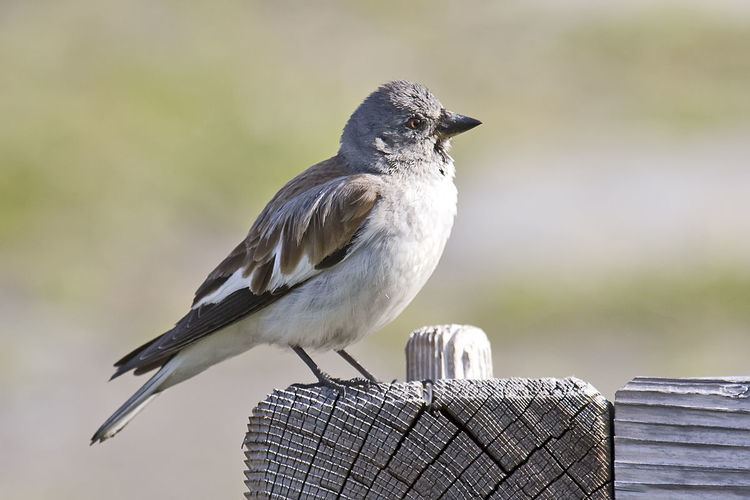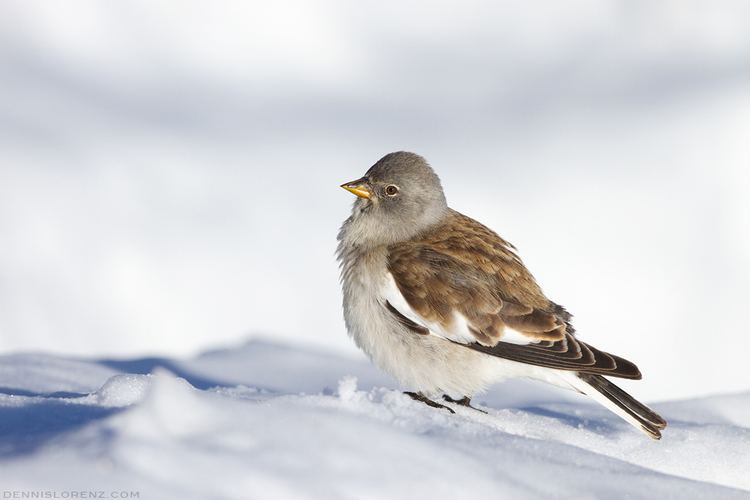Kingdom Animalia Scientific name Montifringilla Higher classification Sparrow Order Passerine | Family Passeridae Phylum Chordata Rank Genus | |
 | ||
Lower classifications White‑winged snowfinch, Tibetan snowfinch, Rufous‑necked snowfinch, White‑rumped snowfinch, Blanford's snowfinch | ||
The snowfinches make up the passerine bird genus Montifringilla. Despite their common name, they are Old World sparrows (family Passeridae), not true finches (family Fringillidae). The genus is sometimes split into three.
Contents

As the English and scientific names suggest, these are high altitude species, found in the mountain ranges of southern Eurasia, from the Pyrenees east to the Himalayas, Tibet and western China.

Description

Snowfinches are stocky sparrows 13.5–17 centimetres (5.3–6.7 in) in length, with strong conical bills. They have pale brown upperparts, white underparts and extensive white panels in the wings, which transform them in flight. Adults may have black markings on the chin or around the eyes. Sexes are usually very similar, although the male white-winged snowfinch has a distinctive grey head. Young birds are a drabber version of the adult.

They have simple repetitive songs, given from a rock or during the elaborate circling display flight. The call is a simple chip or similar.
Ecology
Most snowfinches breed above altitudes of 3,500 metres (11,500 ft), but the white-winged snowfinch can occur from 1,800 metres (5,900 ft) upwards. These hardy birds inhabit bare open mountain grassland. Snowfinches are not migratory but may move to lower altitudes or human habitation in winter, when these highly gregarious birds form large flocks. Snowfinches are primarily ground-feeding seed-eaters, though they also consume small arthropods, especially when breeding. They are typically fearless, and will forage around ski resorts, human habitation and rubbish tips.
They nest in rock crevices, or more typically in holes left by rodents or (and even more often) pikas (Ochotonidae). The typical clutch is from three to six eggs.
Species and systematics
The seven or eight species generally recognized are:
The latter four or five species are quite often separated in a genus Pyrgilauda, based on different vocalizations and ecological preferences. Similarly, the white-rumped snowfinch is occasionally placed in a monotypic genus Onychostruthus. But the evidence is equivocal; though the proposed three lineages of snowfinches seem indeed to be distinct (and can be split), it is not at all certain that the snowfinches are not a monophyletic group (where splitting would become necessary). Thus, without conclusive evidence that Montifringilla sensu lato is paraphyletic with its closest relatives – the petronias (or rock sparrows, Petronia) and the pale rockfinch (Carpospiza brachydactyla) –, Onychostruthus and Pyrgilauda are usually lumped with Montifringilla to avoid maintaining three small or monotypic genera.
Taxonomy
The junior synonyms of Montifringilla have a convoluted history. Pyrgilauda is probably the most confused case among them: It was first established by Charles Lucien Jules Laurent Bonaparte as a junior synonym of Pyrrhulauda, and attributed to the brothers Edouard and Jules Verreaux. But Pyrrhulauda – established by Andrew Smith before Bonaparte – actually refers to certain sparrow-larks, today all placed in Eremopterix. J. Verreaux indeed seems to have been the first to formally use Pyrgilauda for a particular snowfinch species, but that was only in 1871, when he described the small snowfinch. It was widely used for the southern snowfinch species in the late 19th and early 20th century, and continues to be used by some authors today.
According to Article 11.6.1. and 50.7. in the third and fourth editions of the International Code of Zoological Nomenclature, the genus Pyrgilauda was thus validly established by Bonaparte as a possible snowfinch genus name – even though he did not intend to – because many authors after J. Verreaux used it for these birds, and not for the sparrow-larks. Bonaparte had correctly used Montifrigilla for the white-winged snowfinch – the only snowfinch known then – however, and thus Pyrgilauda had remained an unused "shell" of a taxon until someone placed a species in it. That was done by J. Verreaux, and thus many erroneously attributed authorship of the genus to him, although as per the ICZN Code Article 69.3. he technically just fixed its type species as the small snowfinch. Another error occurred in 1982, when G. N. Kasin believed Pyrgilauda had been established twice, and thought the snowfinch genus name – which he believed to have been established by Verreaux in 1870 – was the junior homonym of Bonaparte's sparrow-lark synonym. He set up Stepaniania to replace it. But with Bonaparte's name (as co-opted by Verreaux and later authors) being a valid junior subjective synonym and not preoccupied, Stepaniania itself becomes a junior objective synonym of Pyrgilauda.
The name Orospiza has a similar history to Pyrgilauda. Bonaparte merely remarked it had been used by "some" (aliquī) unspecified authors, while many subsequent sources attributed it to Johann Jakob Kaup. But that is a misunderstanding, and the only technically valid (though synonymous) name for the snowfinch genus proposed by Kaup was Chionospina. Thus, in the case of Orospiza Bonaparte is again the valid author, though Thomas Horsfield and Frederic Moore were the first to set a type species. As M. nivalis was still the only known snowfinch in 1858 when they did this, Orospiza is a junior objective synonym of Montifringilla.
For somewhat different reasons, Orites is a junior objective synonym of Montifringilla. First proposed for the long-tailed tit (Aegithalos caudatus) in Moehring's Geslachten der Vogelen in 1758, that widely ignored work was suppressed as a source of taxa by the International Commission on Zoological Nomenclature in 1987. Consequently, later attempts to re-establish that name as a junior synonym of Aegithalos are preempted by the erection of Orites for the white-winged snowfinch by Eugen von Keyserling and Johann Heinrich Blasius in 1840. Meanwhile, Kaup's Chionospina was misspelled "Chionospiza" by George Robert Gray. As it, too, is a junior objective synonym of Montifringilla, Ludwig Reichenbach's subsequent valid establishment of that name is still inconsequential – except for purely taxonomic purposes, as it makes neither Kaup nor Grey the valid author of Chionospiza, but Reichenbach. And finally, Onychostruthus had to be established because Onychospiza, Nikolai Przhevalsky's 1876 name for the proposed monotypic genus of the white-rumped snowfinch, was preoccupied. It had been given by Rey to the chestnut-eared bunting (today Emberiza fucata) in 1872 already, as an unnecessary correction – and thus junior objective synonym – of Bonaparte's original Onychospina.
